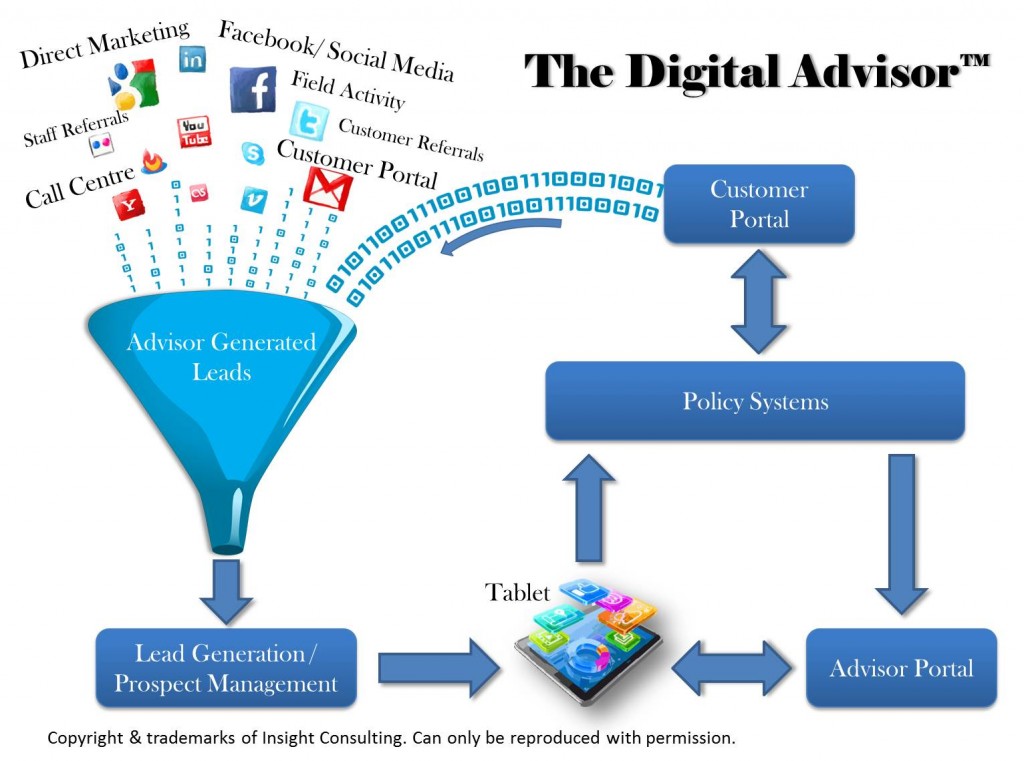The Digital Advisor Business Model: A Transformation Opportunity
In this article we outline a business model, we call it the Digital Advisor, that is intended to equip face-to-face advisors for the opportunities presented by digital technology. In the process you can transform your entire organisation.
Change, change, change … it is all around us
We once used to marvel at how much had changed in our grandparents’ lives. I used to love hearing stories from my grandmother, who was born in 1902 in the East End of London, about growing up in an era when planes and motor cars were the “new”emerging technologies but milk, coal and ice were still being delivered by horse cart. In 1895 an innovative Locomotive Act was passed in the UK that increased driving speeds for cars to 14 miles per hour (just over 20 km per hour) – the debate about the right speed in parliament was framed in reference to what would be deemed to be ‘furious driving’ in relation to a horse. It replaced the Red Flag Act of 1865, an act sponsored by the railway barons of the age, which restricted cars to a speed limit of 2 miles per hour!
However, it has become clear over the last 10 years that we are in the midst of a technological revolution that dwarfs previous changes. If we cast our minds back to the turn of the millennium it was a world without Google, Facebook, Digital tablets, Apps and Smart phones. Apple was in the doldrums, Microsoft was the tech champion, Google had just launched a “search engine” and Mark Zuckerberg (of Facebook) was 15 years old.
These changes have wrought enormous changes in consumer behaviour and expectations. And we are still at an early stage. As more and more people engage with the new technologies it is changing nearly every business model. We are seeing widespread user adoption of new technological devices and in many cases business are struggling to keep up.
The speed of change is certainly faster than in my grandmother’s generation and executives today do not have the luxury of waiting for “things to settle down”. As a senior executive you may have ended up on the wrong side of the digital divide. You may even personally dislike the digital world that is emerging and are perhaps a self-confessed “technological luddite”. But to deny that these changes will have an impact on life insurance business models is pretty much a guarantee to turn your business into the “old nag” that was delivering coal of my grandmother’s generation. It took the UK 30 years to replace the Red Flag Act to increase speeds faster than a horse after the car was invented, and another 35 years to fully repeal that “innovative” 1896 Locomotive Act – I doubt our industry has even 5 years to grasp the impact of the changes that have occurred in the last 10 years.
Insurers – a typical starting point
Insurers’ implementation of technology benchmarks badly against banks let alone some of the leading online brands (Google, Facebook, etc). Back end policy system typically date from the 1970’s and most companies have a number of “add-on” systems that do specific functions such as workflow imaging, quotes and call logging. Unfortunately most of these “add-ons” have been implemented in functional silos – and as a result they do not add up to an integrated capability that aligns to the needs of the business. As a result most organisations are unprepared to take advantage of the latest technologies – or met the changed consumer demands for users of those technologies.
In addition there is a risk that in an attempt to catch up, insurers dig a bigger hole by continuing with piecemeal and uncoordinated technology investments.
This article outlines a new business model,we have named it The Digital Advisor model, that can set your organisation onto a path to a more secure and brighter future. The Digital Advisor model allows you to achieve 5 main benefits:
- Use digital technology to simplify the communication of complex products to both your advisors and their customers
- To manage leads from multiple lead sources (including the emerging digital lead sources)
- To use tablet technology to improve sales effectiveness of advisors
- To provide portals to advisors that allow them to access the information they need when they need it
- To implement portals with customers that not only provide information but can be used for up-sell and referral
The Digital Advisor is an integrated model designed for business leaders looking for change and wanting to use technology as the lever to change and achieve business goals. It is not targeted particularly at technical specialists – except to the extent that it can help them to articulate the need for change within their own organisations.
Let’s be clear that we don’t believe that the fundamental principle that life insurance is always sold will change. And the good news is that the changes can, and in practice must, still be delivered incrementally on top of existing investments. The advisor is dead, long live The Digital Advisor …
The Digital Advisor – defining the model
[quote align=”center” color=”#999999″]The Digital Advisor is the technologically assisted adviser of the future. The Digital Advisor is both able to, and comfortable with, work on the move and has a modern digital toolkit that supports all aspects of his business from lead generation to customer servicing.[/quote]
Some points that are contained within this definition:
- Working on the go: Technology supporting the mobile nature of the job and increasing consumer preference for “anytime, anywhere” access to personal and business information
- End-to-end and consumer focused: A comprehensive toolkit. There is more than one tool and by inference some of those tools are customer facing
- Accepted: The advisor needs to be comfortable using the technology – that is a combination of high usability (think Apple type design standards), great training and good old-fashioned reliability
- Modern: The toolkit is “modern” by which we mean it needs to incorporate the latest hardware trends (think tablets), mobile trends (think great usability) and social trends (connecting the advisor to his contacts via social media)
- Channel neutral: The Digital Advisor could be an agent, Bancassurance adviser or financial planner with an IFA / Broking firm. The same model, with appropriate modifications and different emphasis, can be deployed across all face-to-face distribution channels
The Digital Advisor™ – model details
The picture below summarises The Digital Advisor model we have developed and are executing for insurance clients in the Asia-Pacific region.
Let’s look briefly at each component of the model. The picture provides a high level view of the toolkit needed to support The Digital Advisor of the future. Let’s briefly discuss each component in turn starting at the top left hand side and going anti clockwise.
More Leads: The first thing to notice is that The Digital Advisor will transition away from a “single source” of leads to a multiple source of leads. And many of these new lead sources will be technology assisted. Expect Facebook and LinkedIn to emerge as great source of lead generation as they are already the “virtual cafe’s” for many of us.
Lead Generation Management: The increasing number of leads combined with multiple lead sources mean that existing lead / contact management systems are not going to meet future requirements. Insurers are starting to invest in systems that allow leads to be channeled to individuals, possibly via shared lead pools, and then managed by the advisor directly.
Tablet: Tablet emerged only in 2010 yet it is already clear they are having a profound impact. The tablet is a fantastic tool for advisors to use directly with their customers. So The Digital Advisor needs a customer facing tablet tool that covers needs analysis, quotation and digital proposal submission.
Advisor Portal: The Digital Advisor needs easy access to customer policy data, training records, recruitment data (for team leaders), performance data / benchmarking and pipeline status information. The Advisor Portal, which is not customer facing, is a core part of The Digital Advisor toolkit and will be an essential infrastructure investment.
Policy System: Most insurers with scale have adequate back-end policy administration systems. Little innovation has occurred in the last 20 years and little is predicted in the next 20. Innovation will be built around, not inside, policy administration systems. The Digital Advisor model allows these developments to be coordinated within an overall framework.
Customer Portal: Internet-based customer portals will emerge as a key communication channel as insurers start to co-partner with their advisors and become more consumer focused. Well designed, consumer centric portals will cement customer loyalty and provide opportunities for successful cross sell and up-sell. Embedded into customer (and advisor) service interactions will be multi-channel customer support technology that will include support for online knowledge bases, email, call and social media support inside a single database with a consistent method of case management and case escalation.
Many insurers have some of these components in place. Very few have all in place and in our experience none have sufficiently “connected” the dots from a strategic, operational and technical perspective to create a smooth integrated model.
Benefits of The Digital Advisor Model
The table summarises the key benefits of the model:
| Business Benefit | Success will be come from where? | How to measure? |
| Increase in volume of leads | Modern lead generation capabilities generate more and better leads | % increase in leads (hard benefit) |
| Higher rates of sales closing | Customer focused and advisor friendly tablet technology | % increase in sales closing ratios (hard benefit) |
| Improved compliance & effectiveness | Tablet technology ensures pre sales processes can be monitored for compliance, promote sales best practice & eliminate need to return to branch office for admin chores | Reduction in compliance issues. Less variation in sales performance (soft benefit) |
| Improved cost effectiveness | – Reduced physical infrastructure costs for distribution – Faster more accurate processing of digital proposals – More cost-effective customer servicing including online fulfillment of the majority of service requests |
Reduction in per policy issuance and renewal costs (hard benefit) |
| Increasing customer satisfaction | – Through more effective selling and an improvement in customer service – Technologies to allow satisfaction to be measured at a detailed level |
Surveys (soft benefit) |
| Business intelligence (BI) | – The Digital Advisor model generates enormous amounts of data and makes that information accessible to all – This BI will be used to generate insights to further improve the business and create a virtuous circle |
Will contribute to improvements in all key success metrics |
In our view and experience, the benefits from the Digital Advisor are very clear, impact most key performance metrics, and as a result it is possible to get senior management interested and to build a financial case. We find it is best to make the business case on the basis of the impact on sales performance as success in this area will allow all of the other benefits to be realised in years to come.
Seize the opportunity – and start building the future
So you’ve done the prep, got the CEO sign off and now you are ready to go?
Of course in practice it is not that simple. And the reality is that The Digital Advisor model will take an insurer at least 2 years to deploy – so you need to plan for quick wins and incremental improvements within your overall deployment approach. In addition, insurers are rarely in a position to start from scratch so you will need to have a hard-headed assessment of which existing infrastructure investments can support your Digital Advisor model and identify where you need to invest in both technology and people to support the change. In short, you will need a road map.
As always people and process will matter as much as the quality of the technology deployed – make sure you have an experienced business leader in charge of the digital future you are building. And be prepared for all of the people who will say it isn’t possible and the hundreds of objections that will be raised that will need to be overcome. Strong support from the CEO and the key functional leads (distribution, operations and technology) will be a prerequisite for success.
Good luck on your Digital Advisor journey!
The Digital Insurer can help
If you need help on using digital thinking to transform your business, please get in touch – we are here to help. Please also visit the Q&A area as well as our pages on our Digital Insurance Services.
Share this article – and learn more
Please feel free to share this article with your colleagues. And don’t forget to Sign Up to our email newsletter to be the first to see future articles that are posted on The Digital Insurer.
If you have comments and suggestions on this article or for future articles, please contact us directly or just leave a comment below.
Related articles that explore The Digital Advisor model further include:
- Tablet based sales tools : The Digital Advisor Tablet (DAT)
- Best practice for Advisor portals
- Customer portals : key success factors
- Implementing a Tablet sales tool
- Conference presentation on the Digital Advisor and Tablet tools
- Implementing an Advisor portal (coming soon)
- Implementing a Customer portal (coming soon)

























































